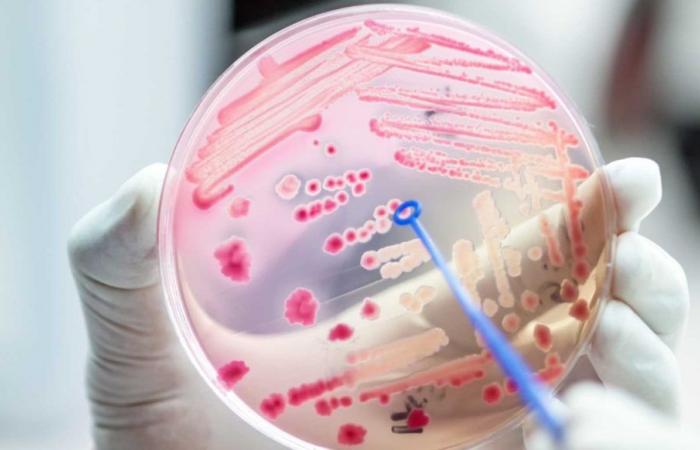Most clinically approved antibiotics only kill gram-positive bacteria.
A new antibiotic reduces or eliminates drug-resistant bacterial infections in mouse models of acute pneumonia and sepsis, while preserving healthy microbes in the mouse intestine. The drugcalled lolamycin, also prevented secondary infections due to clostridioides difficilea common and dangerous hospital-associated bacterial infection, and was effective against more than 130 multidrug-resistant bacterial strains in Cell cultures. This work from the University of Illinois at Urbana-Champaign (United States) is published in Nature.
“People are starting to realize that the antibiotics we’ve all been taking, which fight infections and, in some cases, save our lives, are also having harmful effects on us,” he says. Paul Hergenrother, professor of chemistry at the University of Illinois at Urbana-Champaign. Hergenrother, who led the study with former PhD student Kristen Munoz. «They are killing our good bacteria while treating the infection. “We wanted to start thinking about the next generation of antibiotics that could be developed to kill pathogenic bacteria and not beneficial ones.”
Numerous studies have found that antibiotic-related alterations of the gut microbiome increase vulnerability to new infections and are associated with gastrointestinal, kidney, liver and other problems. «Most antibiotics Clinically approved drugs only kill gram-positive bacteria or kill both gram-positive and gram-negative bacteria,” says Muñoz.
Gram positive and Gram negative bacteria differ in the composition of their cell walls. Gram-negative bacteria have a double layer of protection, which makes them more difficult to kill, adds Muñoz. The few drugs available to combat gram-negative infections also kill other potentially beneficial gram-negative bacteria. For example, colistin, one of the few gram-negative antibiotics approved for clinical use, can cause C. difficile-associated diarrhea and pseudomembranous colitis, a life-threatening complication. The drug also has toxic effects on the liver and kidneys and “therefore, colistin is typically used only as an antibiotic of last resort,” the researchers wrote.
To address the numerous problems associated with indiscriminately attacking Gram-negative bacteria, the team focused on a suite of drugs developed by the pharmaceutical company AstraZeneca. These drugs inhibit the Lol system, a lipoprotein transport system unique to gram-negative bacteria and genetically distinct in pathogenic and beneficial microbes. These drugs were not effective against gram-negative infections unless researchers first weakened key bacterial defenses in the laboratory. But because these antibiotics appeared to discriminate between beneficial and pathogenic Gram-negative bacteria in cell culture experiments, they were promising candidates for further exploration, Hergenrother adds.
In a series of experiments, Muñoz designed structural variations of Lol inhibitors and evaluated their potential to combat gram-negative and gram-positive bacteria in cell cultures. One of the new compounds, lolamycin, selectively targeted some “laboratory strains of gram-negative pathogens, including Escherichia coli, Klebsiella pneumoniae, and Enterobacter cloacae,” the researchers found. Lolamycin had no detectable effect on gram-positive bacteria in cell cultures. At higher doses, lolamycin killed up to 90% of clinical isolates of multidrug-resistant E. coli, K. pneumoniae, and E. cloacae.
When administered orally to mice with sepsis or drug-resistant pneumonia, lolamycin rescued 100 percent of the mice with sepsis and 70 percent of the mice with pneumonia, the team reported. Extensive work was done to determine the effect of lolamycin on the gut microbiome.
«The mouse microbiome is a good tool for modeling human infections because the human and mouse gut microbiomes are very similar,” Muñoz said. “Studies have shown that antibiotics that cause intestinal dysbiosis in mice have a similar effect in humans.”
The team found that treatment with standard antibiotics amoxicillin and clindamycin caused dramatic changes in the overall structure of bacterial populations in the mouse intestine, decreasing the abundance of several beneficial microbial groups.
“In contrast, lolamycin did not cause any drastic changes in taxonomic composition over the course of the three-day or the next 28 days of recovery», the researchers wrote.
Many more years of research are needed to expand the findings, Hergenrother says. Lolamycin or other similar compounds should be tested against more bacterial strains and detailed toxicological studies must be carried out. Any new antibiotic must also be evaluated to determine how quickly it induces drug resistance, a problem that arises sooner or later in bacteria treated with antibiotics.







